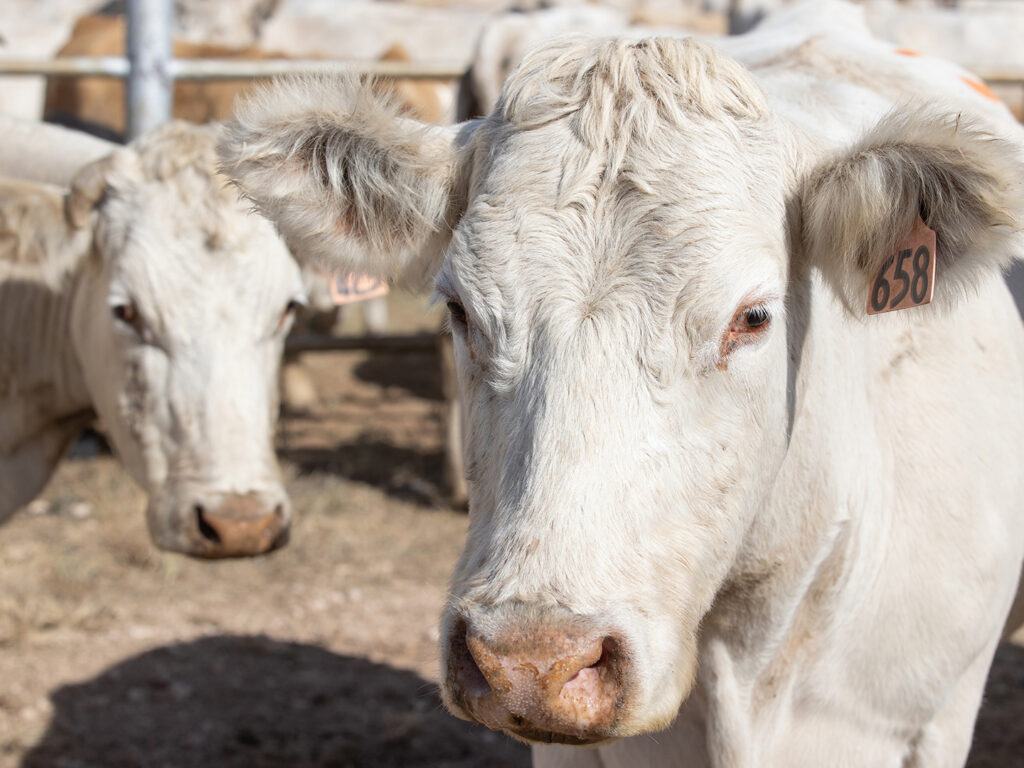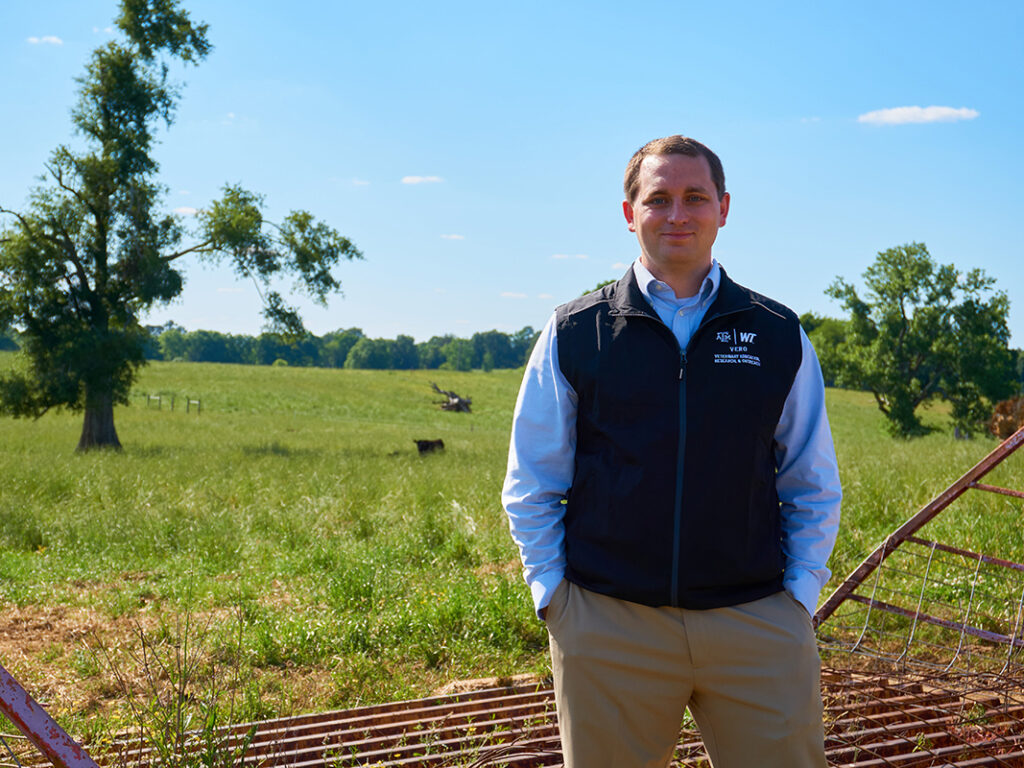Texas A&M-Led Team Receives USDA Grant To Study Cattle Respiratory Disease Prevention
Story by Courtney Price, VMBS Communications

Researchers from the Veterinary Education, Research, & Outreach (VERO) program at the Texas A&M School of Veterinary Medicine & Biomedical Sciences (VMBS) have received $300,000 from the United States Department of Agriculture’s National Institute of Food and Agriculture to study the costliest disease in the cattle industry, bovine respiratory disease (BRD).
The grant will fund a highly collaborative project involving Mississippi State University, West Texas A&M University and Texas A&M AgriLife that looks at the effects of vaccination and management strategies on the cattle immune system and microflora, specifically as it relates to BRD.
BRD costs the cattle industry around $1 billion each year in prevention, management and treatment fees, as well as in herd losses. Though scientists have studied BRD for decades, the ability to accurately predict which individual animals will contract BRD remains elusive, making management strategies less effective.
Old Problems
For the last 50 to 60 years, BRD has been the No. 1 cause of disease and death in cattle feedlots of North America. It has a high morbidity rate, accounting for 35 to 50% of all diagnosed disease, which means that infected herds often experience significant losses.
Despite having been the focus of research for decades, BRD is difficult to prevent because there are many factors that can affect whether an individual animal contracts BRD.
“Age, proximity to other cattle with BRD, vaccination status and individual immune response are just some of the contributing factors,” said Dr. Matthew Scott, an assistant professor of microbial ecology and infectious disease at VERO.
The variety of factors can make it hard to predict exactly which animals will get sick and which ones will resist infection.
“Sometimes low-risk cattle still get sick,” Scott said. “Sometimes really high-risk cattle — the ones coming from multiple sources with no management or vaccines at all — don’t get sick. So, there’s a lot of incongruences at the individual level and we don’t really know why.”
“Given how much the industry loses to BRD, the economic benefits of the research can’t be overstated.”
Dr. Matthew Scott
Vaccines and management strategies, such as physically separating cattle that are vulnerable to BRD, are typically the most reliable way to keep cattle healthy.
“Those are the two main tactics we have in preventing BRD,” Scott said. “We can use these tactics to predict whether a herd is at high or low risk for BRD infection, which is information crucial to producers who may be buying or selling those animals.”
Separating out animals that have been deemed vulnerable to BRD can mean keeping them away from commercial sale barns, where hundreds or thousands of animals may be brought together, putting their immune systems in jeopardy and making it easier for BRD to spread.
“It’s the equivalent of having your kid start kindergarten,” Scott said. “All these kids go to school for the first time, and after the first week everyone has a runny nose. Cattle can be no different in that regard.”
Unfortunately, risk assessment only helps scientists predict general patterns of BRD transmission; it hasn’t been successful in predicting which individual cows will get sick.
New Strategies
The goal of the new NIFA-funded project is to try to understand what makes some cattle more susceptible to BRD than others. Scott and his team expect the project to take about two years.
“We have two main objectives,” Scott said. “First, we’re going to take samples from a variety of cattle and keep track of them throughout their entire life cycle. This way, we can know which cows eventually get sick and which ones don’t. Then, we can look at their gene expression and see what may be affecting their immune systems on the molecular level.
“Secondly, we’re going to look at samples taken from the upper respiratory tracts of these animals to analyze the microbial community — things like bacteria, viruses and fungi that may be present — so we can understand how they may be affecting the cattle’s internal ecosystem,” he said.

This stage of the project will also include examining what is called the host transcriptome, which is the measurement of all the messenger RNA in an animal at a given time. Having all that information allows researchers to see the expression and function of approximately 20,000 genes at one time.
Comparing the microbial community with the host transcriptome will give researchers an incredibly detailed picture of what’s going on inside cattle respiratory systems at the cellular and molecular level. Together with the life cycle data, Scott and his team will be able to see what factors impact susceptibility at both the macro and micro levels to an unprecedented degree.
To get the necessary data, Scott’s team will collaborate with several cattle facilities, including the AgriLife Beef Management Station in Bushland and Prairie Livestock in Mississippi, which is affiliated with Mississippi State University.
Scott’s team will also partner with West Texas A&M University for sample collection and data analysis.
Ongoing And Future Directions
Conveniently, the new project shares quite a bit of overlap with an ongoing VERO-led research project that is now in its third year, in collaboration with AgriLife, Mississippi State University, Kansas State University and West Texas A&M University. In fact, the new project will collect samples from the same groups of cattle as the ongoing one, which saves time for the researchers.
“The ongoing project takes a more traditional epidemiological approach,” Scott said. “We’re looking at how different management strategies and the use of vaccination influence rates of BRD in cattle using health markers in the blood. For example, how much does choosing not to move calves through a sale barn keep them safe from infection?”
The information from the combined projects goes toward assisting researchers in developing new and more effective strategies, including vaccines, for helping prevent, detect and treat BRD.
“Given how much the industry loses to BRD, the economic benefits of the research can’t be overstated,” Scott said.
###
For more information about the Texas A&M College of Veterinary Medicine & Biomedical Sciences, please visit our website at vetmed.tamu.edu or join us on Facebook, Instagram, and Twitter.
Contact Information: Jennifer Gauntt, Director of VMBS Communications, Texas A&M College of Veterinary Medicine & Biomedical Sciences, jgauntt@cvm.tamu.edu, 979-862-4216


